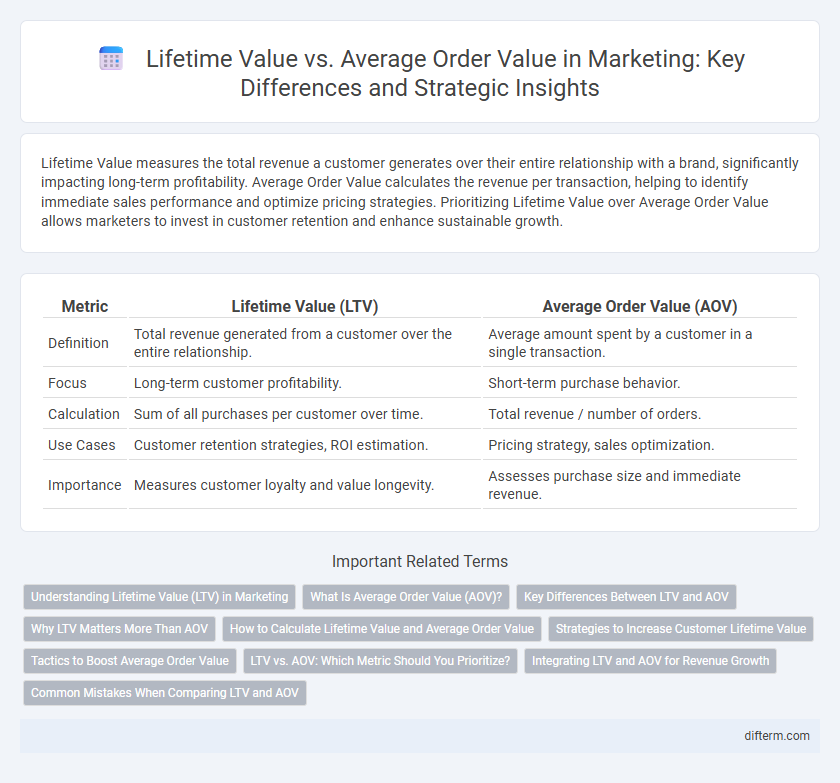Lifetime Value measures the total revenue a customer generates over their entire relationship with a brand, significantly impacting long-term profitability. Average Order Value calculates the revenue per transaction, helping to identify immediate sales performance and optimize pricing strategies. Prioritizing Lifetime Value over Average Order Value allows marketers to invest in customer retention and enhance sustainable growth.
Table of Comparison
| Metric | Lifetime Value (LTV) | Average Order Value (AOV) |
|---|---|---|
| Definition | Total revenue generated from a customer over the entire relationship. | Average amount spent by a customer in a single transaction. |
| Focus | Long-term customer profitability. | Short-term purchase behavior. |
| Calculation | Sum of all purchases per customer over time. | Total revenue / number of orders. |
| Use Cases | Customer retention strategies, ROI estimation. | Pricing strategy, sales optimization. |
| Importance | Measures customer loyalty and value longevity. | Assesses purchase size and immediate revenue. |
Understanding Lifetime Value (LTV) in Marketing
Understanding Lifetime Value (LTV) in marketing is crucial for optimizing customer acquisition costs and maximizing long-term profitability. LTV measures the total revenue a business can expect from a single customer throughout their entire relationship, providing deeper insights beyond Average Order Value (AOV), which only captures the revenue per individual transaction. Accurately calculating LTV helps marketers tailor retention strategies and allocate budgets more effectively to high-value customer segments.
What Is Average Order Value (AOV)?
Average Order Value (AOV) measures the average amount spent each time a customer places an order, calculated by dividing total revenue by the number of orders. It provides insights into customer purchasing behavior and helps marketers tailor pricing, promotions, and product strategies to maximize revenue. Tracking AOV alongside Lifetime Value (LTV) enables businesses to optimize acquisition costs and increase overall profitability.
Key Differences Between LTV and AOV
Lifetime Value (LTV) measures the total revenue a customer generates over their entire relationship with a brand, while Average Order Value (AOV) calculates the average amount spent per individual transaction. LTV provides insights into long-term customer profitability and retention strategies, whereas AOV focuses on optimizing immediate purchase revenue. Understanding the distinction between these metrics helps marketers tailor campaigns to boost both customer loyalty and per-transaction spending.
Why LTV Matters More Than AOV
Lifetime Value (LTV) captures the total revenue a customer generates over their entire relationship with a brand, making it a more comprehensive metric than Average Order Value (AOV), which reflects only a single transaction's worth. Focusing on LTV allows marketers to allocate budgets efficiently, targeting customer retention and repeat purchases rather than just maximizing immediate sales. Brands leveraging LTV insights can design personalized campaigns that foster long-term loyalty and sustainable growth, outperforming strategies based solely on AOV.
How to Calculate Lifetime Value and Average Order Value
Calculate Customer Lifetime Value (CLV) by multiplying the Average Order Value (AOV) by the purchase frequency and the average customer lifespan in months or years. Determine Average Order Value by dividing total revenue during a specific period by the number of orders placed within that period. Accurate CLV and AOV calculations enable marketers to optimize customer acquisition strategies and forecast revenue more effectively.
Strategies to Increase Customer Lifetime Value
Maximizing Customer Lifetime Value (CLV) requires personalized marketing strategies, such as segmented email campaigns and loyalty programs that enhance repeat purchases. Investing in customer experience improvements and post-purchase engagement fosters long-term relationships, increasing retention rates and overall profitability. Leveraging data analytics to predict buying behavior enables targeted upselling and cross-selling, effectively boosting both CLV and brand loyalty.
Tactics to Boost Average Order Value
Implementing upselling and cross-selling tactics significantly enhances Average Order Value (AOV) by encouraging customers to purchase premium products or complementary items. Offering bundled discounts and limited-time promotions effectively increases transaction size while maintaining profitability. Optimizing website user experience with personalized recommendations drives higher customer engagement and boosts overall sales revenue.
LTV vs. AOV: Which Metric Should You Prioritize?
Lifetime Value (LTV) measures the total revenue a customer generates over their entire relationship with a brand, while Average Order Value (AOV) indicates the average spend per transaction. Prioritizing LTV over AOV provides deeper insights into long-term customer profitability and guides strategies for retention and upselling. Focusing on LTV enables marketers to allocate budgets more effectively, optimizing lifetime profitability rather than short-term revenue spikes.
Integrating LTV and AOV for Revenue Growth
Integrating Lifetime Value (LTV) and Average Order Value (AOV) provides a comprehensive approach to maximizing revenue by targeting both customer retention and transaction size. By analyzing LTV, marketers can identify high-value customer segments, while optimizing AOV strategies, such as upselling and cross-selling, encourages larger purchases within those segments. Combining these metrics enables data-driven decisions that enhance marketing ROI, customer engagement, and sustainable growth.
Common Mistakes When Comparing LTV and AOV
Confusing Lifetime Value (LTV) with Average Order Value (AOV) often leads to poor marketing decisions due to their fundamentally different metrics; LTV measures total revenue from a customer over time, while AOV captures revenue per single transaction. Overlooking customer retention rates and purchase frequency skews comparisons, causing marketers to misjudge campaign effectiveness and budget allocation. Ignoring the time dimension in LTV calculation and relying solely on AOV can result in underestimating long-term profitability and customer loyalty impact.
Lifetime Value vs Average Order Value Infographic

 difterm.com
difterm.com